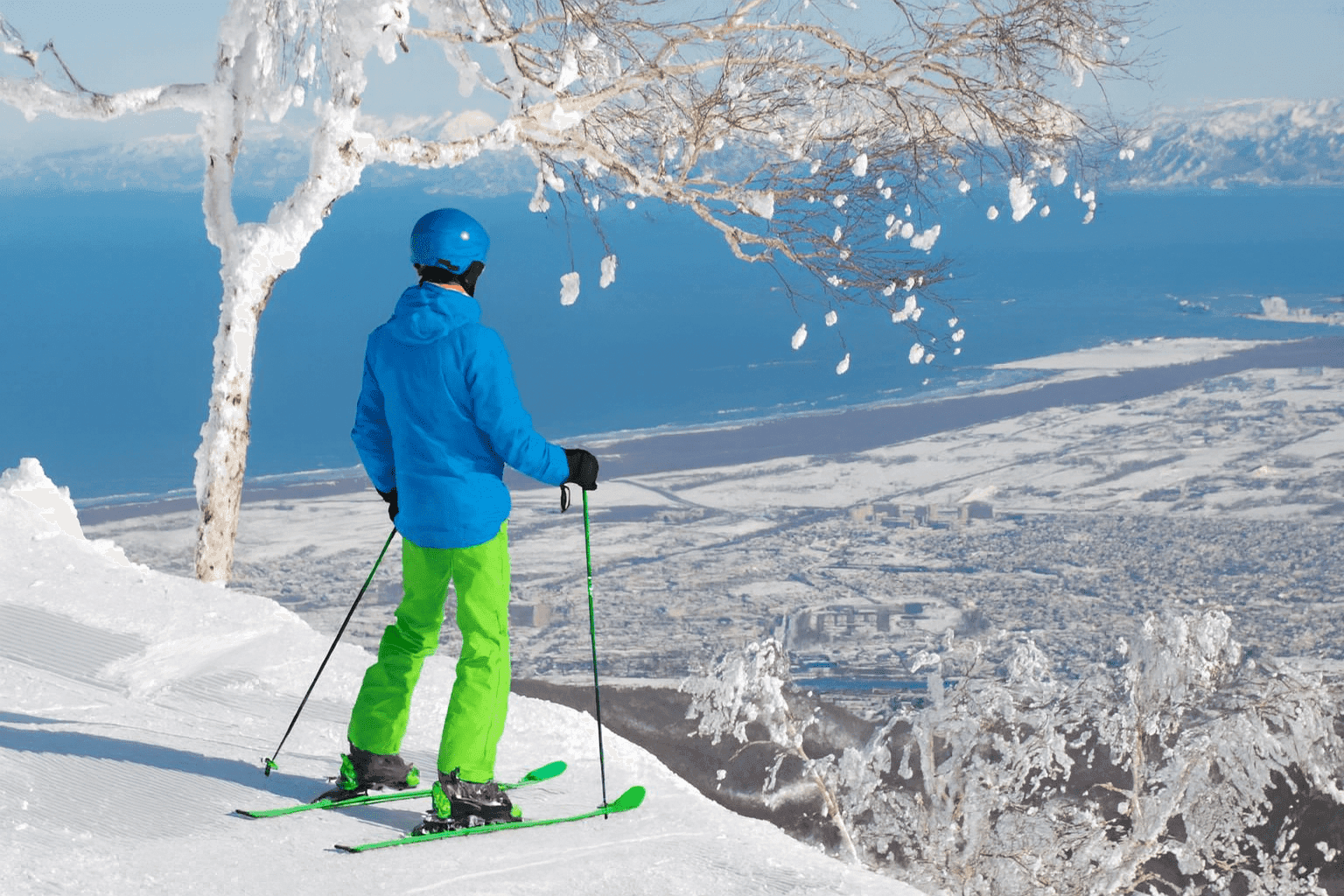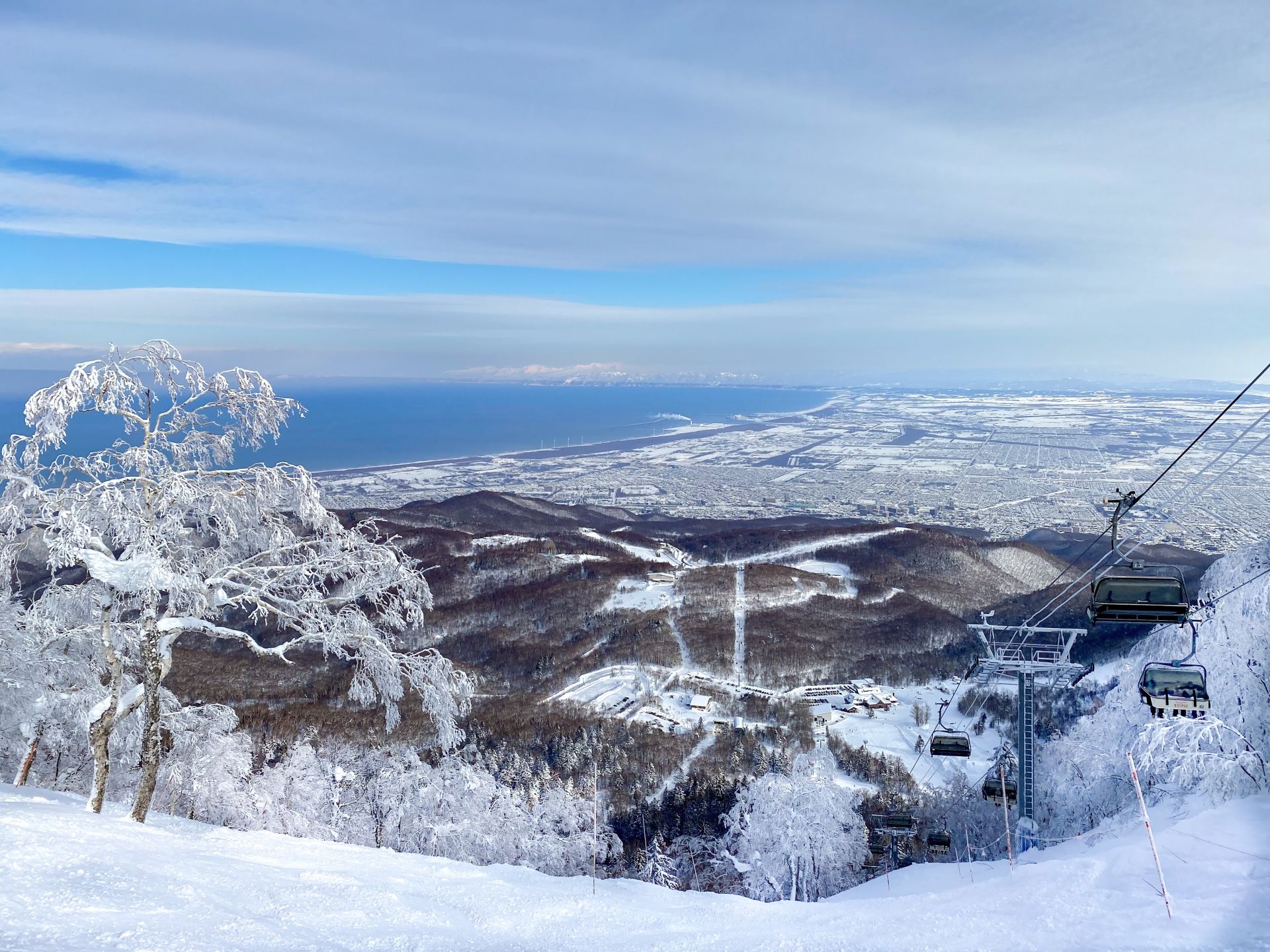Sapporo Teine
City-side Japow with Olympic bite

テイネ
Pow right behind the city
Sapporo Teine is the locals’ powder fix — a real mountain with an Olympic pedigree sitting above a 1.9-million-person city. On bluebird days you’ll stare across Sapporo to Ishikari Bay; on storm days you’ll surf cold, dry chop through sheltering trees. The layout splits into playful, beginner-friendly Olympia down low and steeper, snowier Highland up top, linked by the Eight Gondola and a gentle cruise.
Teine’s vibe is distinctly Hokkaido: no mega-resort veneer, just efficient lifts, a few retro touches, and a crowd that knows how to ski. Weekdays feel uncrowded; Saturdays can jam at Olympia with school groups and families, while Highland keeps a more powder-chaser rhythm. English signage and ticketing are easy enough; you’ll hear Aussie accents in line, but this is still very much a local hill.

If you’re hunting for the goods, Highland is the draw. From the Summit Express quad, the Kitakabe (North Face) pitches and the permitted nature zones deliver silky turns and beautifully spaced trees. Push a little farther toward the old cable-car bowls and you’ll find short-and-sweet shots with consistent fall line — exactly the sort of terrain where one storm day becomes three.
Part of Teine’s recent buzz is simple: access. You can sleep downtown, eat soup curry, and still click in before 10. Prices are friendlier than Niseko, package bus + lift deals make it painless, and the “city-pow” proposition means you can chase snow in the morning and be back under neon by dinner.
Resort Stats
- Vertical683m (1023m → 340m)
- Snowfall~10m
- Terrain 35% 40% 25%
- Tree Riding
- Lift Pass$53
- Lifts1 gondola, 8 chairs
- Crowds
- Out of BoundsDesignated in-bounds
- Night Skiing
- Family Friendly
- Trails13
- Skiable Area~76ha
- VibeCity-access powder, locals’ hill
Trail Map

Powder & Terrain
Teine skis bigger than you expect from the numbers. Average snowfall hovers around 10 m per season, and because the hill faces cold maritime air sweeping off the Sea of Japan, the snow lands light and tends to stay that way. The entire resort sits below treeline, so even when visibility drops you can keep riding. Early and late season can firm up when the wind scours the high ridge, but mid-winter is remarkably consistent.
Lift layout is simple and effective. Down low, Olympia is a beginner-intermediate playground with broad boulevards, night skiing, and program lanes for lessons. Up top, Highland concentrates the steeper goods. The Eight Gondola is your weather-proof backbone, whisking you to snow that’s colder, drier, and less trafficked. Some chairs are old-school slow, but the gondola + high-speed quad combination keeps you cycling the fall line when it counts.
Tree skiing is Highland’s calling card. The Kitakabe fall line beneath the quad holds a sweet spot of pitch — steep enough to keep momentum, mellow enough to stay in control when it’s deep. Inbounds “nature zones” are signed and ski brilliantly on storm days thanks to tighter spacing and a sheltered aspect. Tracks appear by late morning on bluebird Saturdays, but that’s where Teine’s micro-features shine: 10 m skiers’ left or right of the obvious fall line and you’re into refreshed panels.

Sidecountry exists, and it rewards restraint and knowledge. Boundaries are roped and clearly marked; patrol is lenient within permitted zones and much stricter about rope-ducking. A short, obvious hike past the old cable-car station opens little bowls and short, sharp shots that spill back toward the gondola traverse. It’s classic slackcountry — beacon, shovel, probe, partner, and an exit plan are non-negotiable. North-facing aspects keep the snow high-quality; wind can load or strip the top, so read the surface before you commit.
Crowd patterns are predictable and easy to game. Weekends funnel families and school groups to Olympia; Highland stays more manageable if you keep moving. Midweek is gold — you’ll often find fresh tracks after first hour, especially if it’s puking and the city crew is at work. Start with Summit Express laps, milk Kitakabe, then swing into the signed nature zones. When legs start protesting, dip to Olympia for cold, smooth cord and a coffee reset before one more top-to-base.
Who's it for?
Pow chasers who love trees and quick-hit storm riding will be right at home. Strong intermediates get a clean progression path: groomers → nature zones → steeper trees, all within a compact footprint. Families and mixed-ability groups win because Olympia is forgiving, clearly laid out, and offers night skiing to extend the day. If you’re chasing mega-resort vertical or endless alpine bowls, you’ll top out after a couple of days — but as a Sapporo base with optional day trips to Kokusai and Kiroro, Teine makes a killer anchor for a week of city-pow.
Accommodation
There’s no on-mountain lodging at Teine — that’s the point. Stay in Sapporo and ride by day, eat and wander by night. Downtown hubs like Odori and Susukino put you close to bus pickups, the subway, and a ridiculous number of restaurants and bars. Choice swings from sleek towers to tidy business hotels with coin-laundry and hot breakfast buffets that actually hit the spot.
If you want views and convenience, the big station-area hotels are tough to beat and give you quick train links plus easy airport transfers. Mid-range properties around Odori and Susukino are ideal for groups — walkable to late-night ramen, convenience stores, and the pickup points for resort buses. If you’re renting a car and like a quieter base, the coast around Otaru gives you sea views and an easy springboard to Kiroro while still keeping Teine in play.
Budget travelers are spoiled. Single-digit nightly rates (in thousands of yen) at business hotels pop up midweek outside festival periods, and you’ll still be clipping in within 40–50 minutes via bus or car. During the Sapporo Snow Festival and New Year holidays, either book early or widen your search a stop or two down the subway line.
Food & Après
Sapporo’s food scene is half the reason to base here. Warm up with soup curry (rich broth, just-soft veg, your spice level) or go classic with miso ramen that sticks the landing after a cold day. Crab and seafood are easy wins near the markets; jingisukan (table-grilled lamb) is the local rite of passage. Izakaya clusters in Susukino and Tanukikōji cover everything from skewers and sashimi to late-night gyoza. Craft beer fans will find taprooms pouring Hokkaido brews, and there’s always a cozy kissaten if you’d rather sip a careful pour-over before turning in.
Apres on-mountain is mellow — this is a day-trip hill — but night skiing over city lights is its own vibe. Wrap with a cocoa in the basehouse, slide the last run to the bus, and by the time your gear’s stashed you’re already deciding between ramen, soup curry, or grill. If you’re adding a cultural note to the trip, set aside an evening for a beer museum visit or a soak at a city onsen before dinner.
Getting There
Fly: New Chitose (CTS) serves the city with frequent domestic and international flights. From CTS, the Rapid Airport train runs to Sapporo Station roughly every 15 minutes.
Train + Bus: From Sapporo Station, hop a local JR train to Teine Station (about 10–15 minutes), then connect to the resort bus from the south exit. Door-to-door from central Sapporo to the base is typically 40–60 minutes depending on connections. IC cards are widely accepted, and winter timetables are reliable even in heavy snow.
Direct Bus / Packages: Hotel shuttle packages that bundle round-trip transport with an 8-hour lift ticket are the easiest option if you’re staying downtown. Book ahead on peak weekends and during holidays.
Car: It’s roughly 40 minutes from central Sapporo in normal winter conditions and just a few minutes from the Teine IC on the Sasson Expressway. Expect black-ice patches in the early morning, routine plow berms after storms, and occasional wind holds up top when it’s nuking. Snow tires are a must; carry a scraper and keep washer fluid topped. Parking is well organized, but fills early on bluebird Saturdays — arrive for first chair.
Taxi / Rideshare: Taxis are plentiful in town and convenient for small groups, but costs add up quickly compared to bus + lift packages. If you’re night skiing at Olympia and staying close to an express bus stop on the return, public transit wins.
Japow Travel Tips
- Lift hours: Typically 9:00–16:45; night skiing at Olympia usually 16:00–20:00 in season.
- Don’t miss the last gondola: If you’re up in Highland and miss the final Eight Gondola, you won’t be able to return from Olympia. Plan your last lap with a buffer.
- Permitted off-piste vs boundaries: In-resort nature zones are allowed; boundary ropes are firm. Patrol can pull passes for rope-ducking.
- Avalanche awareness: Slackcountry is short but consequential. Bring beacon, shovel, probe, and a partner — and know the exits.
- Wind & weather: Highland gets the brunt. When it’s howling up top, trees ski beautifully and Olympia stays sheltered.
- Best window: Late December through February is prime for the coldest, driest champagne pow; March can be fantastic with longer light and calmer wind.
- Lessons & rentals: Ski school programs run in multiple languages on busy weeks; rental shops in town have modern all-mountain and powder shapes. If you’re picky about skis or boards, book ahead or bring your own.
- Lockers & cash: Plenty of coin lockers at bases; most counters take cards, but it’s handy to keep a little cash for snacks and buses.
- Weekday strategy: Hit Summit Express at open, farm Kitakabe, then drift into the nature zones. Save lower-mountain groomers for the afternoon.
- Nearby day trips: Sapporo Kokusai and Kiroro are both about an hour away — easy adds if you’re storm-chasing from the city.
Verdict: City powder, done right
Sapporo Teine is the easiest “yes” in Hokkaido: real snowfall, real terrain, real local flavor — and you’re back downtown for dinner. It won’t drown you in vertical, but with a north-facing tree menu, slackcountry nibbles, and a fast gondola linking the pieces, it satisfies pow cravings fast. Pair it with a Sapporo food crawl and a couple of day trips, and you’ve got a week that punches above its weight without the mega-resort price tag.